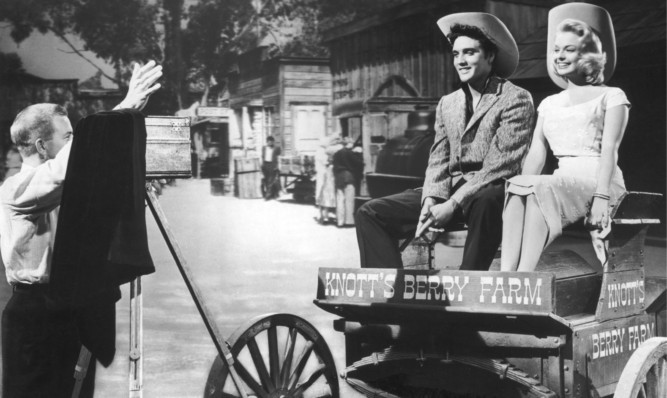
At the start of the 1950s, he was still learning from a kindly neighbour by 1959, he was the biggest star on Earth.
The 50s was the decade where Elvis Presley went from being told to shut up by his teacher, who hated the sound of his voice, to a singer we couldn’t get enough of.
In 1948, sick of listening to him boast of his singing, Presley’s teacher let him bring his guitar into class to prove what he could do. As soon as he finished his song, Keep Them Cold Icy Fingers Off Me, she told him he was woeful and to concentrate on his education. But the young Presley, just 13 years old, got a better reception when the lad next door, a few years older, invited him in and showed him guitar chords. Before long, teachers, pupils, total strangers and record company man Sam Phillips, instead of telling him to shut up, were pleading for him to play another!
https://youtube.com/watch?v=yjTx0P6ZdoM
Even today, millions of tourists head to Memphis to find Sun Studio, on Sam Phillips Avenue, to see what Sam and Elvis would do together they recorded songs that sound as fresh today as they did 60 years ago. Before he met Elvis, Phillips had been responsible for “the first rock ’n’ roll single”, Rocket 88 by Jackie Brenston and his Delta Cats.
Born in Florence, Alabama, Phillips was 13 years older than Presley, had worked as a DJ, then had the unusual job of recording the sound at weddings and even funerals. The fresh-faced young Elvis, 18 and just out of school, dropped into the studio one day in 1953 to ask if he could record a couple of songs for his beloved Mom. Presley could have done it cheaper at a store right across the road, Phillips would wryly recall, so he knew exactly what he was doing coming into Sam’s place.
Asked what kind of material he covered, the boy said: “I sing all kinds, and I don’t sound like nobody.” He was right!
After Elvis did his stuff, an assistant noted in the studio log book: “Good ballad singer hold!” In other words: “Keep an eye on this boy.” Phillips, in those days where the colour of your skin could still prevent you having a career, had been on the hunt for “a white guy who could sing like a black guy”. He had found his guy.
Although his early attempts at getting Elvis to sing in that style didn’t work, the boy showed no signs of giving up. Eventually, he got it, though, and Phillips knew he had something extraordinary.
They’d been recording half the night, and the musicians’ nerves were at breaking point, when Elvis launched into That’s All Right, an up-tempo number by Arthur Crudup, a black songwriter and Blues singer from Mississippi. Phillips would later admit it wasn’t a song he’d asked for, but it was almost like the roof came off his studio.
“I asked: ‘What are you doing?’” Sam recalled. “Elvis said: ‘We don’t know.’ I said: ‘Well, do it again!’”
They recorded it, and a superstar was born everywhere it was played, youngsters got out of their seats and danced. Put it on the jukebox in 2013, and they still do.
Phillips and Sun Records would enjoy massive success through Presley’s earliest recordings, enough for them to record many other top acts. But perhaps their biggest day after That’s All Right was when Elvis came in with some buddies to record new material they were Johnny Cash, Carl Perkins and Jerry Lee Lewis. It became known as the Million Dollar Quartet. Phillips challenged them all to go out and sell enough records to earn a gold disc, offering a gold Cadillac to whoever did it first.
Needless to say, all four would do it.
It all came to a bit of a sad end for the Presley-Phillips partnership Elvis never wished to leave Sun Records, but he had so much debt back then, that when a major record company came in, he couldn’t turn them down. That’s why most of us know our Elvis record collection for the famous orange label of RCA, but it was Sun who made Elvis Presley.
The Hayride, main competitor to the world-famous Grand Ole Opry, also gave Presley a Saturday spot for as long as he wanted it, and this helped bring him to the attention of another special mentor in his life. Colonel Tom Parker was just the man to give Presley that extra little push. Presley admitted he was actually taking half his money, but he also reckoned Parker deserved it for making him a huge star. Within weeks of taking over as manager, Parker would see Elvis’s debut album become the first rock ’n’ roll LP to hit the top of the US Billboard charts. With Blue Suede Shoes among its tracks, it thrilled the nation and stayed at the top for 10 weeks.
Elvis’s first movies would arrive soon, too, as his fame just grew and grew. Even a stint in the US Army couldn’t quite tame his rough edges. However, many believe that as the 50s ended and he returned to Civvy Street, Presley was never the same again. Drugs, women, drink and wealth would spoil that initial spark, and he would be dead at just 42.
But back in the 50s, there was nothing on the planet quite like Elvis Presley.

Enjoy the convenience of having The Sunday Post delivered as a digital ePaper straight to your smartphone, tablet or computer.
Subscribe for only £5.49 a month and enjoy all the benefits of the printed paper as a digital replica.
Subscribe